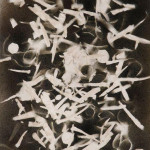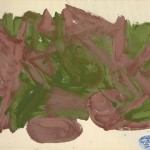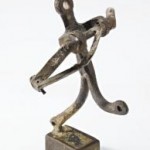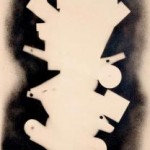Biography
David Smith (1906-1965)
A leading-edge modernist, David Smith created large-scale sculptures in styles ranging from Cubist, Surrealist, and Constructivist. Much of his importance to art historians is the fact that in his sculptures, he pioneered the style of Cubism known as “drawing in space”, and sculpture methods including the creation of large-scale works, welding and the use of industrial materials.
His work emphasized energy and movement, which aligned him with the Abstract Expressionists, especially gestural painters such as Jackson Pollock. Many of these abstracted forms had personal meaning and were comments on social and political issues. As the first recognized American sculptor to employ welding techniques, he was inspired by seeing pictures of welded pieces by Pablo Picasso, Julio Gonzales, and Alberto Giacometti. Members of the Parisian avant-garde were also influential on his work, especially his friend, John Graham, and Stuart Davis, and Arshile Gorky whom he met through Graham.
Smith was born in Decatur, Indiana, the great, great grandson of a blacksmith ad the son of an engineer for the telephone company. As a teenager, he took correspondence courses from the Cleveland Art School and learned machine-shop techniques from working as a welder and riveter in the Studebaker automobile plant in South Bend, Indiana. He went to college briefly and then in 1926 joined the finance department of Studebaker in New York City.
There he met Dorothy Dehner, an artist who encouraged him to enroll with her in classes at the Art Students League, a school he attended until 1931. In 1929, Smith married Dehner, a partnership that lasted until 1952.
Jan Matulka, Czech abstractionist, was his most influential teacher because he exposed him to Cubism and Constructivism and encouraged him to combine objects with painted canvas. Smith also studied with Richard Lahey, and John Sloan and around 1930 was experimented with Surrealist styles.
By 1931, Smith was making constructions and was attaching found objects to paintings including coral and wood that he found during a trip to the Virgin Islands. He began welding steel pieces together and was utilizing ideas he gained from studying reproductions of art by Pablo Picasso and welded metal sculpture of Julio Gonzalez, Spanish artist. By late 1931, he had created his first free-standing sculpture and was working from space he rented in a metal shop at the Brooklyn Navy Pier.
During the Depression he was part of the Federal Art Project doing murals, and also continuing with sculpture, many which were traditional figures of musicians, dancers and bathers. He also searched for a method of creating in sculpture the open-space work that he admired in Picasso’s paintings. With Aerial Construction of 1936, he achieved this goal as it was centered with a hollow space “framed by a network of lines and planes”. (May 48)
During World War II, he worked in a locomotive and tank factory. In the late 1930s, he also traveled abroad including to Russia.
In 1941, he took a factory seven-day-a-week-job at American Locomotive Company in Schenectady, New York, welding locomotives and tanks for the World War II effort. However, his artwork just before the war was an anti-war statement as he did 15 medallions tilted Medals for Dishonor, 1938-1940. They were “jam-packed, complex narrative reliefs depicting everything from racism and sexual violence to mutilated bodies, disease and mortality.” (May 48). Another work in 1939 was Bombing Civilian Populations that featured a woman whose opened womb had a fetus surrounded by bombs.
After the war, he had 35 solo exhibitions in the United States and Europe as well as many group exhibitions. He worked from an open, cinderblock studio at his farm in Bolton Landing, New York and assembled piles of materials from local junkyards and dumps—nuts, bolts, stainless steel, strips of metal tubing, hoses, torches, etc. In fact, it looked more like a machine shop than an artist’s studio. This period was exceedingly productive for him with 35 pieces being completed in the year 1945.
He did not abandon war themes. Tank Totem was done in 1953, and a Tanktotem series VIII was completed in 1960 and painted in vibrant colors. Some of his work was autobiography such as Pillar of Sunday, 1945, which referenced his youth. After 1950, he pursued the making of monumental-size sculptures and welded steel rods into curvy shapes. His sculpture, Australia, is a huge insect-like bird, and over 6 feet tall and 9 feet wide, is now in the collection of the Museum of Modern Art. His method of working was to arrange his sculptures in the fields near his studio, and eighty-nine sculptures were there at the time of his death. Evoking this spacious arrangement, in 1997-1999, a serious of outdoor exhibitions were held on the grounds of the Storm King Art Center in Mountainville, New York, and were titled “The Fields of David Smith”.
He was also a teacher including a visiting professorship at Sarah Lawrence College, and the Universities of Arkansas, Indiana, and Mississippi. In 1965, President Lyndon B. Johnson he appointed Smith to the National Council on the Arts.
His years at Bolton Landing, where he remained until his death in 1965, were highly productive but also isolating, which caused him a lot of unhappiness and anger. However, he did spend a month in Italy in 1962, and using found tools and scraps of steel turned out 27 sculptures in 30 days. Between 1961 and 1965, he did his most famous pieces, his Cubis series, which are pure geometric forms of burnished stainless steel that “have become icons of Twentieth-Century American art.” (May 29)
Smith divorced Dehner in 1952, and shortly after married Jean Freas. They were married until his death in the spring of 1965 when he was driving in Bennington, Vermont and his truck overturned. He is survived by two daughters, Rebecca and Candida.
In the spring of 2006, a retrospective to commemorate the 100th birthday of Smith was held at the Solomon Guggenheim Museum. Titled David Smith: A Centennial, it was curated by the Guggenheim in collaboration with the Centre Pompidou and Tate Modern, which also hosted the exhibition.
Source:
Stephen May, “David Smith: A Centennial Opens at Solomon R. Guggenheim Museum”, Antiques and The Arts Weekly, Februay 24, 2006, pp. 48-49

 A Sketch for a Sculpture (Raven Series)
A Sketch for a Sculpture (Raven Series)
 Untitled (Green/Purple)
Untitled (Green/Purple)
 Dancer
Dancer
 Untitled
Untitled
 Untitled
Untitled